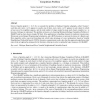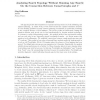11 search results - page 1 / 3 » Optimal strong parity edge-coloring of complete graphs |
COMBINATORICA
2008
13 years 4 months ago
2008
A parity walk in an edge-coloring of a graph is a walk along which each color is used an even number of times. Let p(G) be the least number of colors in an edge-coloring of G havi...
COLOGNETWENTE
2010
13 years 1 months ago
2010
Given a bipartite graph G = (S, T, E), we consider the problem of finding k bipartite subgraphs, called "clusters", such that each vertex i of S appears in exactly one o...
CORR
2011
Springer
12 years 8 months ago
2011
Springer
Consider a linear [n, k, d]q code C. We say that that i-th coordinate of C has locality r, if the value at this coordinate can be recovered from accessing some other r coordinates...
AIPS
2011
12 years 8 months ago
2011
The ignoring delete lists relaxation is of paramount importance for both satisficing and optimal planning. In earlier work (Hoffmann 2005), it was observed that the optimal relax...
JAIR
2011
2011
Analyzing Search Topology Without Running Any Search: On the Connection Between Causal Graphs and h+
12 years 7 months ago
The ignoring delete lists relaxation is of paramount importance for both satisficing and optimal planning. In earlier work, it was observed that the optimal relaxation heuristic ...


